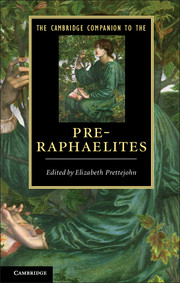Book contents
- Frontmatter
- Introduction
- PART ONE PRE-RAPHAELITISM
- PART TWO PRE-RAPHAELITES
- 6 The poetry of Dante Gabriel Rossetti (1828–1882)
- 7 The painting of Dante Gabriel Rossetti
- 8 William Holman Hunt (1827–1910)
- 9 John Everett Millais (1829–1896)
- 10 Ford Madox Brown (1821–1893)
- 11 Christina Rossetti (1830–1894)
- 12 Elizabeth Eleanor Siddall (1829–1862)
- 13 The writings of William Morris (1834–1896)
- 14 The designs of William Morris
- 15 Edward Burne-Jones (1833–1898)
- 16 Algernon Charles Swinburne (1837–1909)
- 17 William Michael Rossetti (1829–1919)
- 18 Envoi
- Appendix 1 The contents of The Germ
- Appendix 2 The Pre-Raphaelite ‘list of Immortals’
- Guide to further reading and looking
- Cambridge Companions to …
- Index
9 - John Everett Millais (1829–1896)
from PART TWO - PRE-RAPHAELITES
Published online by Cambridge University Press: 28 September 2012
- Frontmatter
- Introduction
- PART ONE PRE-RAPHAELITISM
- PART TWO PRE-RAPHAELITES
- 6 The poetry of Dante Gabriel Rossetti (1828–1882)
- 7 The painting of Dante Gabriel Rossetti
- 8 William Holman Hunt (1827–1910)
- 9 John Everett Millais (1829–1896)
- 10 Ford Madox Brown (1821–1893)
- 11 Christina Rossetti (1830–1894)
- 12 Elizabeth Eleanor Siddall (1829–1862)
- 13 The writings of William Morris (1834–1896)
- 14 The designs of William Morris
- 15 Edward Burne-Jones (1833–1898)
- 16 Algernon Charles Swinburne (1837–1909)
- 17 William Michael Rossetti (1829–1919)
- 18 Envoi
- Appendix 1 The contents of The Germ
- Appendix 2 The Pre-Raphaelite ‘list of Immortals’
- Guide to further reading and looking
- Cambridge Companions to …
- Index
Summary
John Everett Millais's position within Pre-Raphaelitism is unusual. For most early commentators he was its undoubted leader. His painting Christ in the House of His Parents (Figure 4) brought the PRB to public notice in 1850. His later paintings, beginning with A Huguenot, on St Bartholomew's Day of 1852 (Figure 11), were the first to find popular favour, and his was the style that was taken up by the earliest imitators of the movement. However, for later writers, Millais's position has seemed less secure. His two colleagues, Hunt and Rossetti, both had partisans who claimed for them the decisive role in the creation of Pre-Raphaelitism. Rossetti became the model for later artists such as Burne-Jones, to the extent that the term ‘Pre-Raphaelite’ in the public imagination often refers to his style. For others, it is Hunt who is the ‘true Pre-Raphaelite’. He created its distinctive blend of realism and artifice, and remained consistent throughout his career.
Hunt's reputation follows his own account of the PRB, while Rossetti's was sanctified by his brother William. Their importance is thus enshrined in the founding literature of Pre-Raphaelitism. Millais wrote almost nothing. His biography was written by his son John, who believed that his father's later paintings, created after he had abandoned Pre-Raphaelitism, were his best. Later critics condemned these works as ‘sentimental’ or ‘academic’. Millais was seen almost as a Pre-Raphaelite fellow-traveller.
- Type
- Chapter
- Information
- The Cambridge Companion to the Pre-Raphaelites , pp. 133 - 147Publisher: Cambridge University PressPrint publication year: 2012



